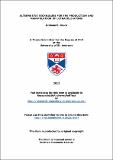Files in this item
Alternative techniques for the production and manipulation of ultracold atoms
Item metadata
| dc.contributor.advisor | Cassettari, Donatella | |
| dc.contributor.author | Bruce, Graham D. | |
| dc.coverage.spatial | 155 | en_US |
| dc.date.accessioned | 2012-05-23T10:59:21Z | |
| dc.date.available | 2012-05-23T10:59:21Z | |
| dc.date.issued | 2012-06-20 | |
| dc.identifier.uri | https://hdl.handle.net/10023/2617 | |
| dc.description.abstract | This Thesis contains details of the construction and characterisation of a compact apparatus for the cooling of ultracold atoms to quantum degeneracy, and their manipulation in flexible holographic optical traps. We have designed and built two iterations of this apparatus. The first version consists of a stainless steel single-cell vacuum chamber, in which we confine ⁸⁷Rb and ⁶Li or ⁷Li in a Magneto-Optical Trap. We characterise the alternative methods of pulsed atomic dispenser and Light Induced Atomic Desorption (LIAD) to rapidly vary the background pressure in the vacuum chamber with the view to enabling efficient evaporative cooling in the single chamber, loading MOTs of up to 10⁸ atoms using pulsed dispensers. The LIAD is found to be ineffective in loading large MOTs in this setup, while the pulsed dispensers method gradually increases the background pressure in the chamber over time. Based on the results of this first iteration, we designed and built a second single-chamber apparatus for cooling of ⁸⁷Rb to quantum degeneracy. The LIAD technique was used to successfully load MOTs containing 8x10⁷ atoms in this single pyrex cell with a rapidly-varying background pressure. The lifetime of an atomic cloud loaded from the MOT into a magnetic trap increased by a factor of 6 when LIAD was used. The holographic optical traps for cold atoms are generated using a Spatial Light Modulator, and we present our novel method for improving the quality of holographic light patterns to the point where they are suitable for trapping ultracold atoms using a feedback algorithm. As demonstrations of this new capability, we show power-law optical traps which provide an efficient, reversible route to Bose-Einstein Condensation and a dynamic ring trap for the investigation of superfluidity in cold atoms. | en_US |
| dc.language.iso | en | en_US |
| dc.publisher | University of St Andrews | |
| dc.rights | Creative Commons Attribution 3.0 Unported | |
| dc.rights.uri | http://creativecommons.org/licenses/by/3.0/ | |
| dc.subject | Ultracold atoms | en_US |
| dc.subject | Holographic optical traps | en_US |
| dc.subject | Light-induced atomic desorption | en_US |
| dc.subject | Pulsed atom traps | en_US |
| dc.subject | Hologram calculation | en_US |
| dc.subject | Smooth atom traps | en_US |
| dc.subject | Feedback algorithm | en_US |
| dc.subject.lcc | QC689.5L35B88 | |
| dc.subject.lcsh | Laser cooling | en_US |
| dc.subject.lcsh | Cold gases | en_US |
| dc.subject.lcsh | Low temperatures | en_US |
| dc.title | Alternative techniques for the production and manipulation of ultracold atoms | en_US |
| dc.type | Thesis | en_US |
| dc.type.qualificationlevel | Doctoral | en_US |
| dc.type.qualificationname | PhD Doctor of Philosophy | en_US |
| dc.publisher.institution | The University of St Andrews | en_US |
This item appears in the following Collection(s)
Except where otherwise noted within the work, this item's licence for re-use is described as Creative Commons Attribution 3.0 Unported
Items in the St Andrews Research Repository are protected by copyright, with all rights reserved, unless otherwise indicated.


